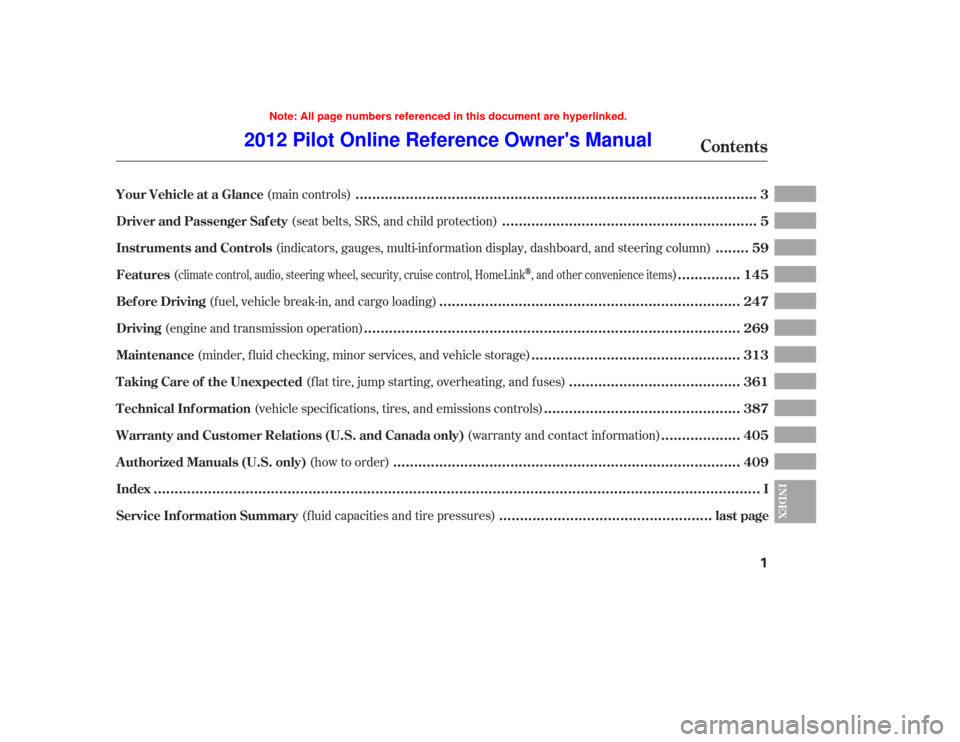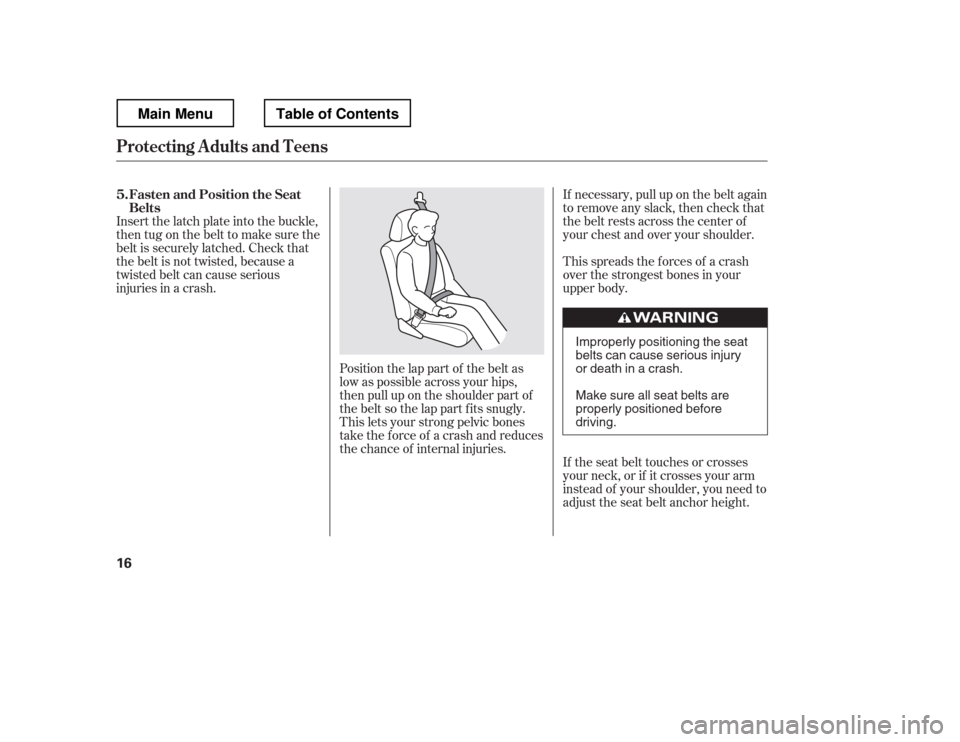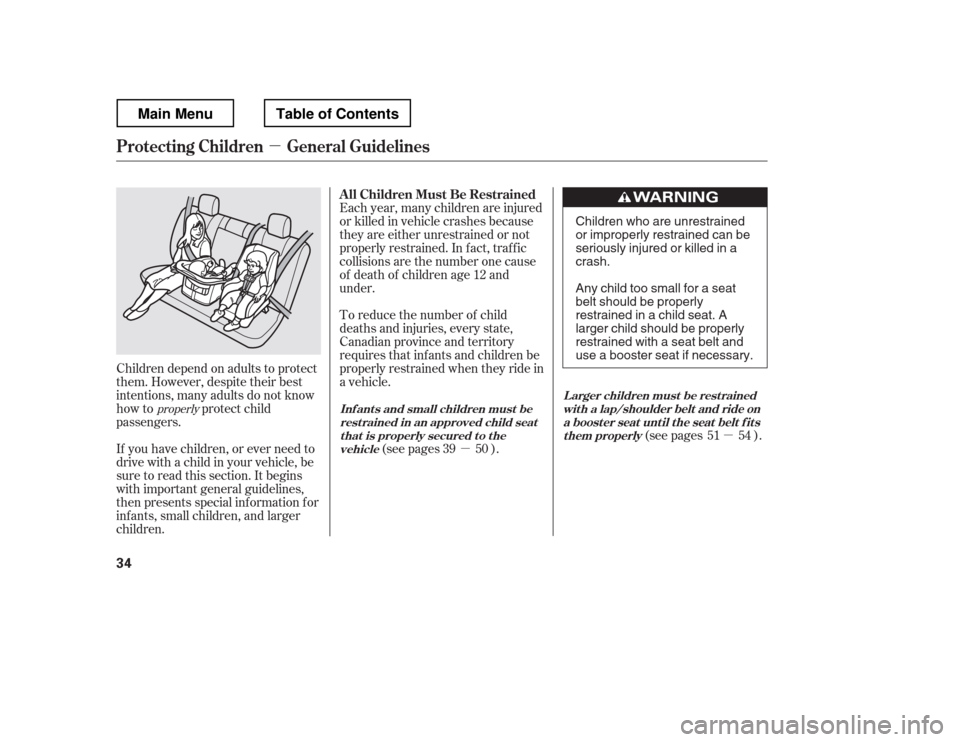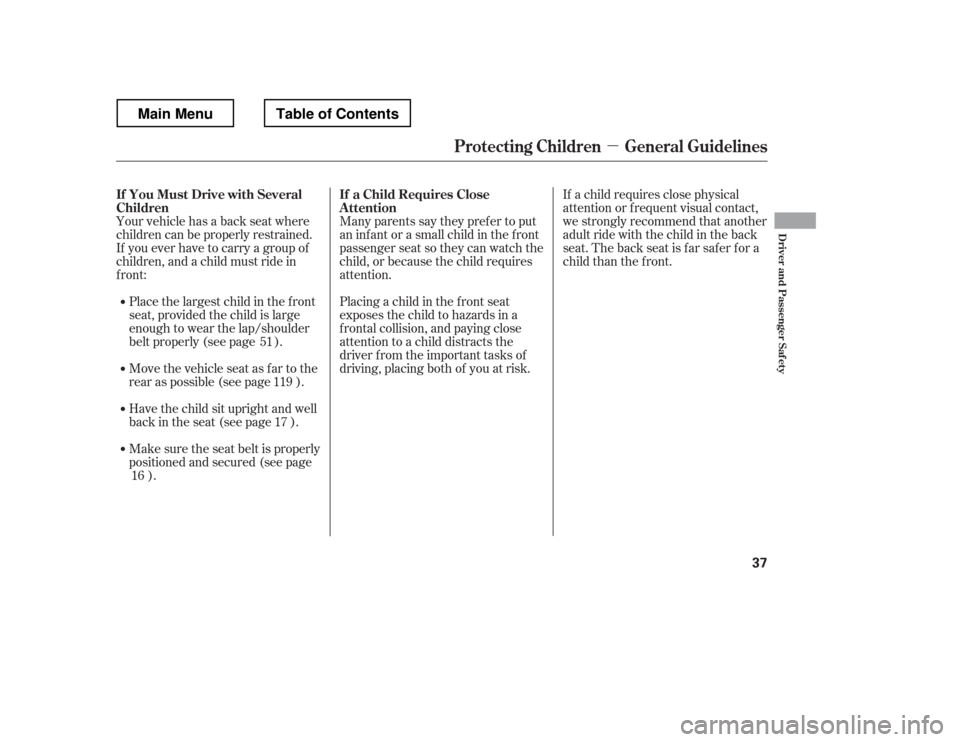Page 8 of 429

(f luid capacities and tire pressures)
(seat belts, SRS, and child protection)
(main controls)
(indicators, gauges, multi-inf ormation display, dashboard, and steering column)
(fuel, vehicle break-in, and cargo loading)
(
)
(engine and transmission operation) (minder, f luid checking, minor services, and vehicle storage)
(f lat tire, jump starting, overheating, and f uses)
(vehicle specif ications, tires, and emissions controls)
(warranty and contact inf ormation)
(how to order)
climate control, audio, steering wheel, security, cruise control, HomeLink, and other convenience items
Contents
................................................................................................................................................
Index .I
..................................................
Service Inf ormation Summary . last page
............................................................
Driver and Passenger Saf ety .5
...............................................................................................
Your Vehicle at a Glance .3
.......
Instruments and Controls .59
.......................................................................
Bef ore Driving .247
..............
Features .145
.........................................................................................
Driving .269
.................................................
Maintenance .313
........................................
T aking Care of the Unexpected .361
..............................................
T echnical Inf ormation .387
..................
Warranty and Customer Relations (U.S. and Canada only) . 405
..................................................................................
A uthorized Manuals (U.S. only) .409INDEX
1
Note: All page numbers referenced in this document are hyperlinked.
2012 Pilot Online Reference Owner's Manual
Page 23 of 429

Position the lap part of the belt as
low as possible across your hips,
then pull up on the shoulder part of
the belt so the lap part f its snugly.
This lets your strong pelvic bones
take the force of a crash and reduces
the chance of internal injuries.
Insert the latch plate into the buckle,
then tug on the belt to make sure the
belt is securely latched. Check that
the belt is not twisted, because a
twisted belt can cause serious
injuries in a crash.
If necessary, pull up on the belt again
to remove any slack, then check that
the belt rests across the center of
your chest and over your shoulder.
This spreads the f orces of a crash
over the strongest bones in your
upper body.
If the seat belt touches or crosses
your neck, or if it crosses your arm
instead of your shoulder, you need to
adjust the seat belt anchor height.
Fasten and Position the Seat
Belts
5.
Protecting A dults and Teens
16 Improperly positioning the seat
belts can cause serious injury
or death in a crash.
Make sure all seat belts are
properly positioned beforedriving.
Table of ContentsMain Menu
Page 41 of 429

�µ
�µ�µ
If you have children, or ever need to
drive with a child in your vehicle, be
sure to read this section. It begins
with important general guidelines,
then presents special inf ormation f or
infants, small children, and larger
children. To reduce the number of child
deaths and injuries, every state,
Canadian province and territory
requires that inf ants and children be
properlyrestrainedwhentheyridein
a vehicle.
(see pages ). (see pages ).
Children depend on adults to protect
them. However, despite their best
intentions, many adults do not know
how to protect child
passengers. Each year, many children are injured
or killed in vehicle crashes because
they are either unrestrained or not
properly restrained. In f act, traf f ic
collisions are the number one cause
of death of children age 12 and
under.
39 50 51 54
properly
Protecting Children General Guidelines
All Children Must Be Restrained
Inf ant s and small children must be
rest rained in an approved child seat t hat is properly secured t o t hevehicle Larger children must be restrained
wit h a lap/shoulder belt and ride ona boost er seat unt il t he seat belt f it st hem properly
34 Children who are unrestrained
or improperly restrained can be
seriously injured or killed in a crash.
Any child too small for a seat
belt should be properly
restrained in a child seat. A
larger child should be properly
restrained with a seat belt and
use a booster seat if necessary.
Table of ContentsMain Menu
Page 44 of 429

�µ
Many parents say they pref er to put
an inf ant or a small child in the f ront
passenger seat so they can watch the
child, or because the child requires
attention.
Placing a child in the f ront seat
exposes the child to hazards in a
f rontal collision, and paying close
attention to a child distracts the
driver from the important tasks of
driving, placing both of you at risk.
Your vehicle has a back seat where
children can be properly restrained.
If you ever have to carry a group of
children, and a child must ride in
front:
Place the largest child in the f ront
seat, provided the child is large
enough to wear the lap/shoulder
belt properly (see page ). If a child requires close physical
attention or f requent visual contact,
we strongly recommend that another
adult ride with the child in the back
seat. The back seat is far safer for a
child than the front.
Move the vehicle seat as far to the
rear as possible (see page ).
Have the child sit upright and well
backintheseat(seepage ).
Make sure the seat belt is properly
positioned and secured (see page ). 17
16 51
119
If You Must Drive with Several
Children
If a Child Requires Close
Attention
Protecting Children General Guidelines
Driver and Passenger Saf ety
37
Table of ContentsMain Menu
Page 48 of 429
CONT INUED
If it is necessary to put a f orward-
f acing child seat in the f ront, move
the vehicle seat as far to the rear as
possible, and be sure the child seat is
f irmly secured to the vehicle and the
child is properly strapped in the seat.
Even with advanced front airbags
that automatically turn the
passenger
Page 49 of 429
Af ter selecting a proper child seat
and a good place to install the seat,
there are three main steps in
installing the seat:All child seats must be
secured to the vehicle with the lap
part of a lap/shoulder belt or with
the LATCH (Lower Anchors and
Tethers f or CHildren) system. A
child whose seat is not properly
secured to the vehicle can be
endangered in a crash.
Af ter installing a child
seat, push and pull the seat
f orward and f rom side-to-side to
verif y that it is secure.
A child seat secured with a seat belt
should be installed as f irmly as
possible. However, it does not need
to be ‘‘rock solid.
Page 50 of 429

To install a LATCH-compatible child
seat:Make sure there are no objects
near the anchors that could
prevent a secure connection
between the child seat and the
anchors. When using the tether strap on
the child seat, attach the tether
strap hook to the center tether
anchor bef ore installing the child
seat to the lower anchors f or the
LATCH system, because the
center tether anchor is positioned
behind the child seat.
If needed, move the seat belt
buckle or tongue away f rom the
lower anchors.
Whenever using the center tether
anchor point, make sure to push
down the head restraint to the lowest
position, route the strap over the
seat-back, then around the upper
guide bef ore attaching the tether
strap hook to the center tether
anchor (see page ).
The location of each lower anchor is
indicated by a small button above the
anchor point.
The lower anchors are located
between the seat-back and seat
bottom, and are to be used only with
a child seat designed f or use with
LATCH.
Your vehicle is equipped with
LATCH (Lower Anchors and
Tethers f or CHildren) at the rear
seats.
1. 2.3.
49
CONT INUED
On the center seating position
Installing a Child Seat
Installing a Child Seat with
LATCH
Driver and Passenger Saf ety
43
BUTTON CENTER TETHER ANCHOR
LATCH
ANCHOR
POINTS UPPER
GUIDE
Table of ContentsMain Menu
Page 52 of 429
Lif t the head restraint (see page), then route the tether strap
over the seat-back and through
the head restraint legs.
Lift the cover, then route the
tether strap around the upper
guide. Route the tether strap
downward properly, making sure
the strap is not twisted, then
attach the strap hook to the tether
anchor on the outside of the seat
bottom (see page ). Push and pull the child seat
f orward and f rom side-to-side to
verif y that it is secure.
Tighten the strap according to the
seat maker